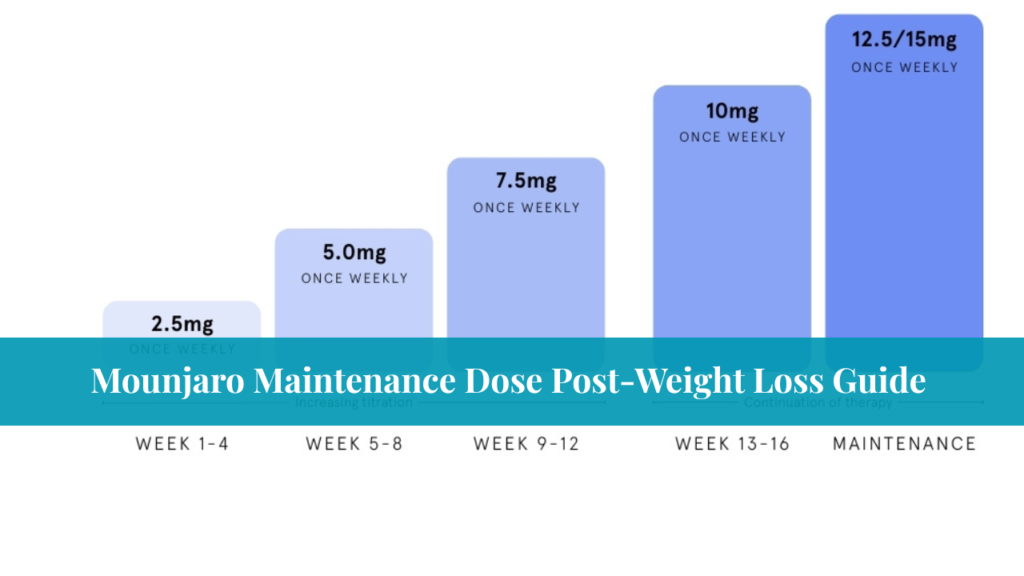Mounjaro, an injectable prescription medication, was originally approved for the treatment of type 2 diabetes. Its active compound, tirzepatide, functions as a dual GIP and GLP-1 receptor agonist. These hormones are critical in managing blood sugar levels, controlling appetite, and regulating the body’s energy usage.
Recently, Mounjaro has gained popularity for its effectiveness in weight loss. By suppressing appetite and helping patients manage food intake, it has become a favored option among those seeking medical support for weight reduction. Its unique mechanism targets both glucose regulation and appetite suppression, giving it a dual benefit that supports both metabolic health and weight management.
Why Consider a Maintenance Dose?
Reaching your goal weight is a major achievement, but suddenly stopping Mounjaro can lead to an unwanted rebound effect. A maintenance dose is key in helping the body adapt gradually, minimizing the chance of regaining the lost weight. It supports metabolic stability and provides a smoother transition into a long-term healthy lifestyle.
This phase plays an essential role in ensuring continued success. A maintenance dose can help keep appetite in check, support psychological well-being, and give your body time to adjust to its new set point. This measured approach prevents metabolic disruption and helps to establish lasting behavioral habits that support weight maintenance.
Recommended Mounjaro Maintenance Dose After Weight Loss
For many patients, the journey begins with a low starting dose and progresses to a higher dosage, often up to 15 mg per week during the active weight loss phase. Once the desired weight is achieved, physicians generally recommend a lower maintenance dose ranging from 5 mg to 7.5 mg weekly, although this may vary depending on the individual.
Those who experienced strong appetite suppression at lower doses may do well on 5 mg, while others might benefit more from a 7.5 mg regimen. In cases where patients are prone to regaining weight or dealing with persistent cravings, doses of 10 mg or more might be selectively prescribed. The right maintenance dose is the one that balances effectiveness with tolerability and minimal side effects.
How Long Should You Stay on the Maintenance Dose?
The duration of the maintenance phase varies from person to person. Some individuals may only require a few months, while others might need to stay on the medication for longer to ensure stability. Factors that influence this decision include how well the body maintains the new weight, the risk of associated health conditions returning, and the ability to stick with healthy eating and lifestyle habits.
Mental health plays a role as well, especially for those who have struggled with emotional eating in the past. Support systems such as health coaches or dietitians can also impact how long someone should remain on the maintenance dose. In a 2024 survey, over two-thirds of Mounjaro users reported maintaining their target weight for six months or more on a maintenance dose, with nearly half continuing usage for over a year without major side effects.
Comparing Mounjaro to Other Maintenance Therapies
Mounjaro is not the only medication used in the weight loss maintenance phase. Other common treatments include Wegovy (semaglutide) and Saxenda (liraglutide). While all three have shown effectiveness, Mounjaro’s dual mechanism offers an added advantage by targeting two hormonal pathways.
Compared to Wegovy and Saxenda, Mounjaro is often praised for its superior appetite suppression and its benefit in blood sugar regulation, especially in individuals at risk for diabetes. Each medication comes with its own side effect profile, but the choice between them often depends on individual response, provider guidance, and insurance coverage.
Tips to Support Long-Term Weight Management
Even with Mounjaro helping manage appetite and metabolism, sustaining weight loss depends heavily on lifestyle choices. Prioritizing a balanced diet rich in protein and fiber, staying hydrated, and minimizing processed foods are all essential. Planning meals ahead of time also helps reduce impulsive eating.
Exercise plays a central role in weight maintenance. A consistent mix of cardiovascular activities and strength training not only supports calorie burning but also boosts mood and energy levels. Engaging in regular physical movement, whether through gym sessions or daily walks, is key to keeping weight off long-term.
Emotional health is equally important. Mindful eating, identifying emotional eating triggers, and managing stress through meditation or therapy can make a significant difference. Tracking your progress with health apps or journals, scheduling follow-up appointments with healthcare providers, and measuring your results over time can help you stay motivated and informed.
Potential Side Effects of Maintenance Dosing
Though side effects are generally milder during the maintenance phase compared to the dose escalation period, they can still occur. Some users report mild nausea, fatigue, or digestive discomfort. Injection site irritation is also possible but usually manageable.
Long-term use of Mounjaro should be monitored by a healthcare professional. Regular evaluations ensure that the medication continues to provide benefits without causing unnecessary issues. It’s also not uncommon for some individuals to experience “medication fatigue,” a psychological burnout that comes from long-term use. Access to counseling or support groups can help navigate this phase successfully.
Monitoring Progress and When to Adjust the Dose
Being on a maintenance dose doesn’t mean your treatment is static. If you begin to regain weight or notice a return of hunger and old habits, it might be time to revisit your dosage or evaluate your daily routine. In some cases, new side effects might emerge or old ones may worsen, signaling a need for medical review.
Adjusting your dose should always be done under professional supervision. Your healthcare provider can assess whether your current dose is still effective or whether a minor increase or decrease would better support your health goals. Staying in close contact with your care team ensures your plan remains personalized and responsive.
Psychological Impact of the Maintenance Phase
The transition from active weight loss to maintenance can bring unexpected emotional challenges. Some people may fear regaining the weight or feel less motivated without the steady progress seen during the weight loss phase. Others may struggle with changes in self-image or experience anxiety around food choices.
Building a support system is critical. Having a clear strategy for maintenance, engaging in therapy if needed, and practicing mindfulness techniques can ease the mental burden. Cognitive behavioral therapy has shown promise in supporting long-term weight maintenance by helping individuals develop healthier thinking patterns and behavioral responses.
FAQs
What happens if I stop taking Mounjaro after weight loss?
Stopping suddenly can cause increased hunger, reduced metabolic control, and potential weight regain. Gradual tapering under supervision is safer.
Can I increase my dose if I start gaining weight again?
Yes, but only under the guidance of a healthcare provider. Randomly adjusting doses can be risky and ineffective.
Is Mounjaro approved for long-term use?
While it is primarily approved for diabetes, many providers are prescribing it off-label for weight loss maintenance based on promising research.
Are there alternatives to Mounjaro for maintenance?
Yes. Alternatives include GLP-1 agonists like Wegovy and Saxenda, or non-medication routes such as behavior-based weight maintenance programs.
Will insurance cover Mounjaro for maintenance use?
Coverage depends on the provider and plan. You may need documentation proving ongoing medical necessity or significant prior weight loss.
Can I combine Mounjaro with other weight-loss strategies?
Yes. It works best when combined with lifestyle interventions, dietary counseling, and in some cases, other medications.
Case Study: Successful Weight Maintenance with Mounjaro
Sarah, a 43-year-old woman, began her weight loss journey at 210 lbs. Over nine months, she successfully reached her goal weight of 160 lbs with the help of Mounjaro. Once she hit her target, she tapered her dosage from 12.5 mg to a maintenance dose of 7.5 mg.
In combination with her medication, Sarah committed to meal prepping, attending the gym five days a week, and participating in weekly therapy sessions to manage emotional eating. As a result, she was able to maintain her weight within a narrow three-pound range. Her energy levels improved, her mood stabilized, and her metabolic health markers showed consistent improvement. Her success highlights the importance of combining medical treatment with comprehensive lifestyle changes and emotional support.
Conclusion
Achieving weight loss is a huge milestone, but keeping it off is just as important. A Monjaro maintenance dose after weight loss offers a science-backed way to maintain progress and reduce the risk of rebound weight gain. With ongoing support, smart lifestyle choices, and the right dose, long-term success is within reach.
Discuss your maintenance strategy with a qualified provider, and make adjustments based on your evolving health needs. By combining the medication with healthy habits, education, and support, your weight loss journey doesn’t just end, it transforms into a sustainable lifestyle.
For more on long-term weight management strategies, visit boxing essential.




